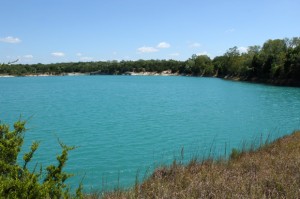
A gate into a silica sand mining operation near Mill Creek in south-central Oklahoma.
Joe Wertz / StateImpact Oklahoma


A gate into a silica sand mining operation near Mill Creek in south-central Oklahoma.
Joe Wertz / StateImpact Oklahoma

Joe Wertz / StateImpact Oklahoma
An aggregate mining operation underway near Mill Creek in South-Central Oklahoma.
There are about a dozen operations currently mining or planning to mine in the area of Mill Creek in Northern Johnston County, which is fed by the Arbuckle-Simpson Aquifer, perhaps the state’s most sensitive water resource.
The limestone in the aquifer is some of the best in world. So good, it’s even an ingredient in toothpaste.
“It’s apparently a phenomenal place to get aggregates,” Amy Ford, of Citizens for the Protection of the Arbuckle-Simpson Aquifer, says. “TXI, which is Texas. Martin-Marietta. There’s U.S. Silica. Some of them are from out of country. When we originally starting kind of discussing this, I was surprised by the varying locations that they came from.”
It’s no coincidence that most of those companies are based in Texas.
The Dallas-Fort Worth area desperately needs the rock to feed its construction needs. Most of the mining operations in the underground layer of waterlogged stone and sand are based out of state, and more are on the way.
Texas companies produce about a fifth of the nation’s supply of concrete mix.
“One of the major consumers of that concrete is the Dallas-Forth Worth metroplex,” Richard Szecsy, President of The Texas Aggregates and Concrete Association, says. “Because they’re a huge consumer of concrete, they’re also a huge consumer of aggregates. So, when you connect those dots, you’re like, ‘wow, they need a lot of rock.’”
That rock is heavy, and the closer it is to where it’s needed, the cheaper it is to transport. Dallas-Forth Worth has been relying on DFW-area resources for decades.
[module align=”left” width=”half” type=”pull-quote”]
“…all of a sudden people are starting to look at those natural resources and go, ‘we don’t have that many left in the ground. We may have ten to 15 years left. We need to go where the good rock is,’”
[/module]
“Well, fast-forward 30-years later, and all of a sudden people are starting to look at those natural resources and go, ‘we don’t have that many left in the ground. We may have ten to 15 years left. We need to go where the good rock is,’” Szecsy says.
And the good rock is on the Arbuckle-Simpson.
It also doesn’t hurt that Oklahoma currently has relatively few regulations when it comes to mining in aquifers.
“When you sever something from the ground in Texas, you pay severance tax. Oklahoma does not have a severance tax,” Ford says.
The Arbuckle-Simpson is a sole source aquifer, meaning it isn’t fed by streams or rivers. It’s only replenished as water seeps into it from the ground above, a process that can take many years.
There’s no specified limit in Oklahoma on how deep into the aquifer companies can mine.
The Mill Creek area is dotted with abandoned quarries that have filled with crystal clear groundwater. And during the mining process, the hole needs to remain dry.

Joe Wertz / StateImpact Oklahoma
After this quarry near a U.S. Silica sand mining operation was mined out, clear blue aquifer water filled it in.
“There’s only one operation that knows how much they’re taking out. They’ve never had to account for the water. So we really don’t know, and we think it’s a large quantity. And we’re dealing with a finite amount of water that can be removed from the aquifer as a whole,” Ford says. “Right now, some of them are putting it in old mining pits. Some of them are putting it in recharge areas. And some of them are just putting it out on the ground.”
There are new regulations coming.
A law passed in 2011 charges the Oklahoma Water Resources Board with creating rules to make sure aquifer water isn’t wasted. Those rules are being worked out now. As the process continues, streams in area are drying up.
The companies put the blame on the ongoing drought, but as we report next week, some homeowners along Mill Creek just aren’t buying that.